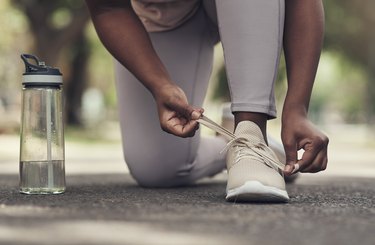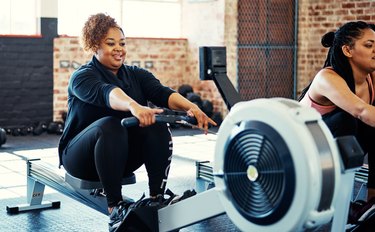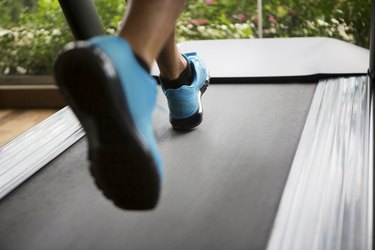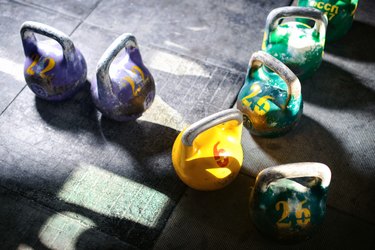
Many people have an ideal weight and body type in mind, and gaining muscle and possibly "bulking up" while shedding fat may not be on their agenda. If that's the case for you, know that watching your calories and sticking to a healthy diet while following a specific exercise routine can help you lose weight and stay toned without building bulky muscle mass.
Keep reading for diet, nutrition and exercise tips (because yes, you should exercise!) on how to lose weight without gaining any muscle.
Video of the Day
Video of the Day
1. Create a Calorie Deficit for Weight Loss
Many factors affect your weight, including your family history, age and where you live.
To lose weight, you'll need to take in fewer calories than you burn and create a calorie deficit. (Physical activity can help you burn more calories — more on that in a moment.)
Since 3,500 calories equals around one pound of fat, you need to burn that many to lose one pound, according to the Mayo Clinic. If you cut approximately 500 to 1,000 calories from your daily diet, you can safely lose 1 to 2 pounds a week.
You can use an online calculator to determine how many calories you need daily to maintain your weight, then get to subtracting to find your new daily calorie target.
Warning
Your calorie intake shouldn't dip below 1,200 per day if you're assigned female at birth (AFAB) or 1,500 per day if you're assigned male at birth (AMAB), unless you’re under the guidance of a medical professional, per Harvard Health Publishing.
Too low of a calorie intake can lead to quick loss of lean muscle mass. While you may not want to gain muscle, losing muscle diminishes your metabolism and makes weight loss more difficult. Plus, if you aren't taking in sufficient calories, you'll lose out on nutrients.
2. Eat Right to Lose Weight
So, what's a good fat-loss diet plan and how do you go about losing 1 to 2 pounds per week? Well, you need start looking at the quality of your daily calories too (not just the quantity), per Harvard Health Publishing. That's because not all calories are created equal.
Understand that a calorie of junk food just isn't the same as a calorie of a nutritious food. Yes, a calorie is a calorie, but the former usually has little to no nutrition while the calories in the latter are accompanied by essential nutrients that your body needs to function and will also keep you fuller longer.
Follow these dietary strategies:
- Choose high-quality foods that give you both calories (energy) and nutrients. Unrefined or minimally processed foods like fruits, vegetables, whole grains like brown rice and quinoa, good fats like avocado and nuts and lean proteins are the best choices to lose weight healthfully.
- Aim for variety. A good diet is a balanced, colorful diet, according to the Centers For Disease Control and Prevention (CDC). That is, you don't want to eat the same thing meal after meal, and day after day.
- Minimize certain foods. You'll want to limit sugary sweets like baked goods and soda, processed snack foods and saturated fats found in fatty meat and full-fat dairy.
3. Don’t Be Afraid to Exercise
Listen up: Participating in no physical activity whatsoever compromises your long-term health. Even if you don't want to build muscle mass, you should be doing the weekly 150 to 300 minutes of moderate-intensity or 75 to 150 minutes of vigorous-intensity cardio, per the recommendations in the Physical Activity Guidelines for Americans from the U.S. Department of Health and Human Services.
Here, a look at the types of exercises to lose fat without gaining muscle:
Low-Intensity Steady State Cardio
Walking, jogging, biking, swimming, etc. are all forms of low intensity steady-state cardio (LISS) — an activity done at a pace you can sustain for an extended period of time (aka, aerobic exercise, which requires the presence of oxygen).
This type of cardio can help burn those calories in order to get and keep you lean, according to the International Sports Sciences Association (ISSA). You'll want to turn to steady-state cardio to lose thigh weight without gaining muscle.
High-Intensity Interval Training
The opposite of LISS, high-intensity interval training (HIIT) is anaerobic, which is exercise that doesn't require the presence of oxygen.
This type of workout involves bursts of high-intensity activity followed by lower intensity recovery times, according to the American College of Sports Medicine, such as alternating sprinting (until you gas out) with walking for 15 seconds. You can burn the most calories in the least amount of time with this type of workout.
Short-term HIIT workouts are so effective that they can lead to a fair amount of body composition improvements without even losing weight, per a study published in June 2017 of Obesity Reviews.
Strength Training
Believe it or not, you can and should be lifting weights — light weights, specifically.
Lean muscle diminishes with age while your body fat percentage increases, according to the Mayo Clinic. Preserving muscle tone through strength training helps with bone strength, certain chronic conditions, protects joints and can even sharpen thinking skills as you age.
In terms of your figure though, light weights can help you tone up and get rid of some jiggle without adding on any bulkiness, per the National Academy of Sports Medicine (NASM). That is, you can lose weight in your arms without getting muscular
A typical program would consist of weight-lifting exercises with a weight that can be lifted by a person 12 to 15 times consecutively, usually for one to three sets.
- Mayo Clinic: "Counting Calories: Getting Back to Weight-Loss Basics"
- Harvard Health Publishing: "Calorie Counting Made Easy"
- Harvard Health Publishing: "There's No Sugar-Coating It: All Calories Are Not Created Equal"
- Centers for Disease Control and Prevention: "Healthy Eating for a Healthy Weight"
- Physical Activity Guidelines for Americans: "Chapter 4: Active Adults"
- International Sports Sciences Association: "Is Cardio Really the Secret to Fat Loss?"
- American College of Sports Medicine: "High Intensity Interval Training"
- Obesity Reviews: "The Effects of High-Intensity Interval Training Vs. Moderate-Intensity Continuous Training on Body Composition in Overweight and Obese Adults: A Systematic Review and Meta-Analysis"
- National Academy of Sports Medicine: "Toning Vs. Bulking Up: What's the Difference?"







